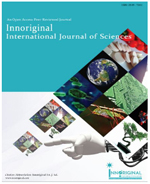IN VITRO CLONAL PROPAGATION OF DIPTERACANTHUS PROSTRATUS (POIR.) NEES. – A VALUABLE MEDICINAL PLANT
Abstract
High frequency in vitro plantlet regeneration protocol for Dipteracanthus prostratus has been developed in this study. Nodal shoot segments were used as explants to establish the cultures. The explants were sterilized using 0.1% HgCl2 solution for 4-5 min. The Murashige and Skoog (MS) medium augmented with 1.0 mg l-1 6-benzylaminopurine (BAP) was reported suitable for bud break from the nodal meristems of the explants. About 4.6 shoots with 3.7 cm length were induced per explant on this medium combination. The shoots were multiplied (31.7 shoots with 5.6 cm length) on MS medium supplemented with 0.5 mg l-1 each of BAP and Kinetin (Kin). The healthy and sturdy shoots were rooted in vitro on half-strength MS medium fortified with 1.5 mg l−1 indole-3-butyric acid (IBA). The rooted plantlets were hardened in the greenhouse using soilrite first in the bottles for 4 week and then in the paper cups for 2 weeks. The hardened plants were transferred to the earthen pots and finally shifted to the natural fields. About 96% plantlets were survived in the field conditions.The developed protocol could be used for mass propagation of this important medicinal plant. The superior planting material can be supplied to the farmers and drug manufactures.Key words: Dipteracanthus prostratus, micropropagation, rooting, hardening.References
Akthar, M. F., S. Rashid, M. Ahmad, and K. Usmanghani. Cardiovascular evaluation of Ruellia patula and Ruellia brittoniana. Journal of Islamic Academy of Sciences, vol. 5, no. 1, pp. 67-71, 1992.
Anonymous. Wealth of India- A dictionary of Indian raw material and industrial products. National Institute of Science Communication, CSIR, New Delhi, India, vol. 5, pp. 360-364, 1959.
Agrawal, S. S. and V. K. Singh. Immunomodulators – A review of studies on Indian medicinal plant and synthetic peptides, Part – 1, Medicinal plants. Proceedings of the Indian National Science Academy, vol. 65, no. B, pp. 179-204, 1999.
Onayade, O. A., J. J. C. Scheffer, and A. B. Svendsen. The importance of phytotherapy and screening of plants used medicinally in Africa. Planta Medica, vol. 56, pp. 503-504, 1990.
Yoganandam, P., K. Sunil, V. Gopal, and K. Muthamizheselvam. Promising anti-leishmanial potentials of Dipteracanthus prostrates (Poir) Nees. in both axenic amastigotes and promastigotes of Leishmania donovani. International Journal of Pharmacology and Toxicology, vol. 4, pp. 19-23, 2014.
Chopra, R. N., S. L. Nasar, and I. C. Chopra. Glossary of Indian medicinal plants. National Institute of Science Communication, New Delhi, India, vol. 99, 1956.
Rastogi, R. P. and B. N. Mehrotra. Compendium of Indian medicinal plants. Publications and Information Directorate, CSIR, New Delhi, India, vol. 2, pp. 280, 1989..
Asolkar, L. V., K. K. Kakkar, and O. J. Chakre. Glossary of Indian medicinal plants with active principles. Part-1, Publications and Information Directorate, CSIR, New Delhi, India, pp. 280, 1992.
Palanisamy, P., B. Jayakar, M. V. Kumuthavalli, Y. Kumar, and K. R. Srinath. Preliminary phytochemical evaluation of whole plant extract of Dipteracanthus prostrates Nees. International Research Journal of Pharmacy, vol. 3, pp. 150-153, 2012.
Maruthupandian, A., V. R. Mohan, and Kottaimuthu Ethnomedicinal plants used for the treatment of diabetes and jaundice by palliyar tribals in sirumalai hills, Western Ghats, Tamil Nadu, India. Indian Journal of Natural Products and Resources, vol. 2, pp. 493-497, 2011.
Robert, J., B. R. Xavier, and C. Louis An efficient in vitro plant regeneration of Dipteracanthus prostrates (Poir.) Nees.- a medicinal herb. Asian Pacific Journal of Tropical Biomedicine, vol. 2, pp. 484-487, 2012.
Murashige, T., F. Skoog. A revised medium for rapid growth and bioassays with tobacco cultures. Physiologia Plantarum, vol. 15, pp. 473-497, 1962.
Shekhawat, M. S., N. S. Shekhawat, Harish, R. Kheta, M. Phulwaria, and A. K. Gupta. High frequency plantlet regeneration from nodal segment culture of female Momordica dioica (Roxb.). Journal of Crop Science and Biotechnology, vol. 14, no. 2, pp. 133-137, 2011.
Phulwaria, M., A. K. Patel, J. S. Rathore, K. Ram, and N. S. Shekhawat. An improved micropropagation and assessment of genetic stability of micropropgated Salvadora oleoides using RAPD and ISSR markers. Acta Physiologiae Plantarum, doi:10.1007/s11738-014-1486-z, 2014.
Lodha, D., A. Patel, and N. S. Shekhawat. A high-frequency in vitro multiplication, micromorphological studies and ex vitro rooting of Cadaba fruticosa (L.) Druce (Bahuguni): a multipurpose endangered medicinal shrub. Physiology and Molecular Biology of Plants, doi:10.1007/s12298-015-0310-6, 2015.
Kataria, V., N. S. Shekhawat. Cloning of Rauvolfia serpentina – an endangered medicinal plant. Journal of Sustainable Forestry, vol. 20, pp. 53-65, 2005.
Patel, A. K., M. Phulwaria, M. K. Rai, A. K. Gupta, S. khawat, and N. S. Shekhawat. In vitro propagation and ex vitro rooting of Caralluma edulis (Edgew.) Benth. & Hook. F.: An endemic and endangered edible plant species of the Thar Desert. Scientia Horticulturae, vol. 165, pp. 175-180, 2014.
Shekhawat, M. S., N. Kannan, M. Manokari. In vitro propagation of traditional medicinal and dye yielding plant Morinda coreia Buch. -Ham. South African Journal of Botany, doi:10.1016/j.sajb.2015.05.018, 2015.
Anand, S. P., E. Jayakumar, R. Jeyachandran, V. Nandagobalan, and A. Doss. Direct organogenesis of Passiflora foetida L. through nodal explants. Plant Tissue Culture and Biotechnology, vol. 22, no. 1, pp. 87-91, 2012.
Shekhawat, M. S., N. Kannan, M. Manokari, and C. P. Ravindran In vitro regernation of shoots and ex vitro rooting of an important medicinal plant Passiflora foetida L. through nodal segment cultures. Journal of Genetic Engineering and Biotechnology, doi:10.1016/j.jgeb.2015.08.002, 2015.
Panwar, D., K. Ram, Harish, and N. S. Shekhawat. In vitro propagation of Eulophia nuda Lindl., an endangered orchid. Scientia Horticulturae, vol. 139, pp. 46-52, 2012.
Rai, M. K., P. Asthana, V. S. Jaiswal, and U. Jaiswal. Biotechnological advances in guava (Psidium guajava L.). Scientia Horticulturae, vol. 21, pp. 1-12, 2010.
Pospsilovia, J., I. Ticha, P. Kadleck, D. Haisel, and S. Plzakova Acclimatization of micropropagated plants to ex vitro conditions. Biologia Plantarum, vol. 42, pp. 481-497, 1999.
Rathore, M. S. and N. S. Shekhawat. In vitro regeneration in Sarcostemma acidum (Roxb.) – an important medicinal plant of semi-arid ecosystem of Rajasthan, India. Physiology and Molecular Biology of Plants, vol. 19, pp. 269-275, 2012.


